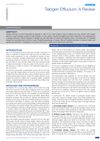TLDR Searches for acne, hair loss, and eczema increased during COVID-19, while searches for other skin issues decreased.
The study analyzed Google Trends data to understand public interest in dermatologic conditions in Turkey and Italy during the COVID-19 pandemic. It found that searches for "acne," "hair loss," and "eczema" increased, while searches for "molluscum contagiosum," "genital warts," "botox," "skin cancer," and "sunscreen" decreased. A significant positive correlation was observed between the number of COVID-19 cases in Turkey and searches for "acne," "hair loss," and "eczema." The findings suggested that psychological stress and increased hygiene measures during the pandemic might have influenced these trends. Understanding these trends can help dermatologists better prepare for patient needs during such crises.
34 citations
,
July 2020 in “Dermatologic Therapy” Searches for acne, hair loss, and eczema increased during COVID-19, while searches for other skin issues decreased.
 31 citations
,
May 2020 in “Dermatologic Therapy”
31 citations
,
May 2020 in “Dermatologic Therapy” Quarantine stress likely worsened hair loss in women, but video consultations helped manage their condition and reduce anxiety.
 70 citations
,
January 2015 in “Journal of Clinical and Diagnostic Research”
70 citations
,
January 2015 in “Journal of Clinical and Diagnostic Research” Hair loss from Telogen Effluvium usually gets better within 6 months after addressing the cause.
18 citations
,
February 2021 in “Dermatologic therapy” Public interest in skin issues changed during COVID-19, with more focus on dry skin, hair problems, and hand eczema.
 4 citations
,
March 2009 in “British Journal of Dermatology”
4 citations
,
March 2009 in “British Journal of Dermatology” The conference highlighted new dermatological treatments and emphasized early intervention and addressing conditions lacking evidence-based treatments.
 7 citations
,
July 2019 in “International archives of internal medicine”
7 citations
,
July 2019 in “International archives of internal medicine” Common skin conditions can greatly affect a person's mental health and social life.
 3 citations
,
December 2022 in “Cells”
3 citations
,
December 2022 in “Cells” Cannabinoids like CBD and THC may help treat non-cancer skin diseases, but more research is needed.
 4 citations
,
March 2006 in “Archives of Dermatology”
4 citations
,
March 2006 in “Archives of Dermatology” The conclusion is that dermatologists can improve women's skin health but must overcome cultural and economic barriers to do so.





